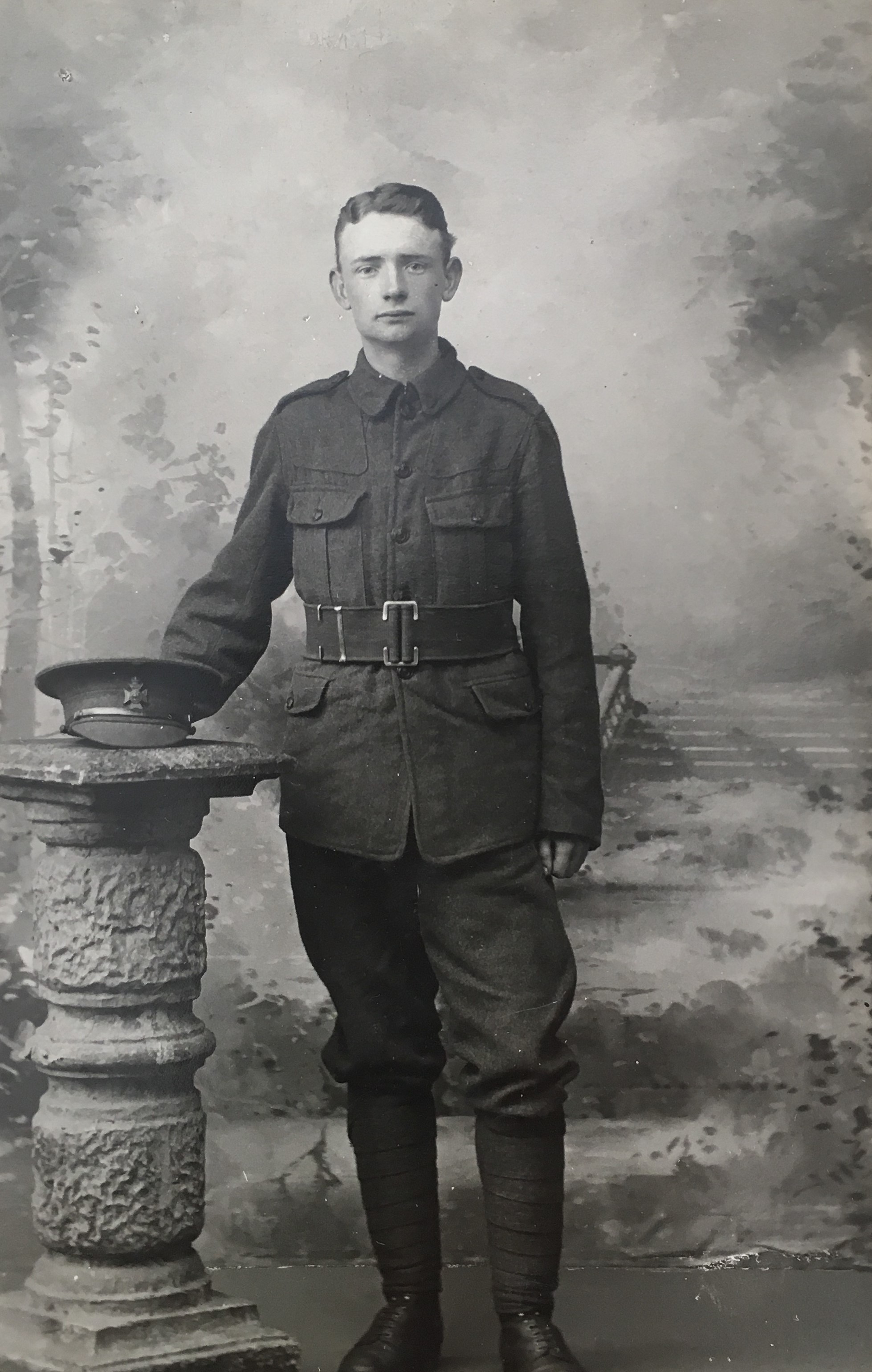Pte
Henry John Shanks
Informationen zu Geburt
|
Geburtsdatum: 11/08/1896 |
|
Geburtsort: Windsor, Berkshire, England, Vereinigtes Königreich |
Allgemeine Informationen
|
Beruf: Textilfachverkäufer |
Informationen zum Armeedienst
|
Land: England, Vereinigtes Königreich |
|
Truppe: British Expeditionary Force |
|
Rang: Private |
|
Dienstnummer: 265855 |
|
Einberufung ort: Burnham, Slough, Buckinghamshire, England, Vereinigtes Königreich |
|
Einheiten: — Oxfordshire & Buckinghamshire Light Infantry, 1/1st Bn. (Buckinghamshire) (Letzte bekannte Einheit) |
Informationen zu Tod
|
Sterbedatum: 17/08/1917 |
|
Sterbeort: No. 3 Australian Casualty Clearing Station, Brandhoek, Belgien |
|
Todesursache: Verwundet |
|
Alter: 21 |
Begräbnisplatz
|
Brandhoek New Military Cemetery No.3 Grabstelle: I Reihe: A Grab: 15 |
Auszeichnungen und Orden 3
|
1914-15 Star Medaille |
|
British War Medal Medaille |
|
Victory Medal Medaille |
Punkte von Interesse 2
| #1 | Geburtsort | ||
| #2 | Einberufung ort |
Meine Geschichte
Henry John Shanks, a draper's assistant from Windsor, Berkshire was killed during the Battle of Passchendaele. Henry served in “D” Company of the Oxfordshire & Buckinghamshire Light Infantry, 1/1st Battalion (145th Brigade, 48th Division).
On the 16th of August 1917, the battalion participated in the battle of Langemarck. It attacked from positions on the Steenbeek stream towards the Zonnebeke-Langemark road. The Gloucester regiment was on the right, the ¼ Ox and Bucks on their left and the ¼ Royal Berks in support. Companies “A” (left) and “B” (right) of the battalion were in the first two waves. “C” and “D” Companies were in the last two. The first objective was a line running through Hillock Farm. The second objective was the Zonnebeke-Langemark road, dominated by Springfield Farm.
The advance began at zero hour, 4.45 a.m. Due to the muddy terrain, the men lost the barrage even before they could reach the German first Line. Without the cover of the barrage, the 1/1st Battalion came under heavy machinegun and rifle fire. The leading wave was almost entirely annihilated. The situation was checked. The situation only changed when "D" Company of the third wave arrived. What followed was man to man fighting at the German positions on the St-Julien - Hillock Farm Road.
“A” Company, on the left, came under heavy fire when they skirted the slight ridge east of the Steenbeek stream. They were fired upon from reinforced positions at Hillock Farm and two gunpits, west of the Farm. Only sixteen men of the leading wave reached the gunpits. The second wave got pinned down, due to fire from Maison du Hibou and Triangle Farm. Only a handful of men reached the objective at Springfield Farm. By 7 a.m. the entire advance had been checked. An hour later Germans were seen massing near the Keerselare Crossroads. At 10 a.m. the Germans attacked Triangle Farm, but the attack was repulsed. At 9.30 p.m. the Germans launched another counterattack near Hillock Farm, compelling the British to retreat from the area, back to the Steenbeek. The battalion was eventually relieved at night.
Henry John Shanks, was heavily wounded during the attack. He was evacuated to the No. 3 Australian Casualty Clearing Station with several shot wounds. Henry, who had just turned 21, succumbed to his wounds on the following day.
On the 16th of August 1917, the battalion participated in the battle of Langemarck. It attacked from positions on the Steenbeek stream towards the Zonnebeke-Langemark road. The Gloucester regiment was on the right, the ¼ Ox and Bucks on their left and the ¼ Royal Berks in support. Companies “A” (left) and “B” (right) of the battalion were in the first two waves. “C” and “D” Companies were in the last two. The first objective was a line running through Hillock Farm. The second objective was the Zonnebeke-Langemark road, dominated by Springfield Farm.
The advance began at zero hour, 4.45 a.m. Due to the muddy terrain, the men lost the barrage even before they could reach the German first Line. Without the cover of the barrage, the 1/1st Battalion came under heavy machinegun and rifle fire. The leading wave was almost entirely annihilated. The situation was checked. The situation only changed when "D" Company of the third wave arrived. What followed was man to man fighting at the German positions on the St-Julien - Hillock Farm Road.
“A” Company, on the left, came under heavy fire when they skirted the slight ridge east of the Steenbeek stream. They were fired upon from reinforced positions at Hillock Farm and two gunpits, west of the Farm. Only sixteen men of the leading wave reached the gunpits. The second wave got pinned down, due to fire from Maison du Hibou and Triangle Farm. Only a handful of men reached the objective at Springfield Farm. By 7 a.m. the entire advance had been checked. An hour later Germans were seen massing near the Keerselare Crossroads. At 10 a.m. the Germans attacked Triangle Farm, but the attack was repulsed. At 9.30 p.m. the Germans launched another counterattack near Hillock Farm, compelling the British to retreat from the area, back to the Steenbeek. The battalion was eventually relieved at night.
Henry John Shanks, was heavily wounded during the attack. He was evacuated to the No. 3 Australian Casualty Clearing Station with several shot wounds. Henry, who had just turned 21, succumbed to his wounds on the following day.
Quellen 6
|
Ancestry https://www.ancestry.com/ Verwendete Quellen |
|
CWGC https://www.cwgc.org/find-war-dead/casualty/140467/shanks,-/ Verwendete Quellen |
|
Mc Carthy C., Passchendaele Day-by-Day account, Unicorn Publishing Group, 2018, London, pp. 54-55. Verwendete Quellen |
|
Naval and Military Archives http://www.nmarchive.com/ Verwendete Quellen |
|
The Long Long Trail http://www.longlongtrail.co.uk/ Verwendete Quellen |
|
Wright, P.L. The First Buckinghamshire Battalion 1914-1919. Londen: Hazell, Watson & Viney, 1920, pp. 69-82. Verwendete Quellen |
